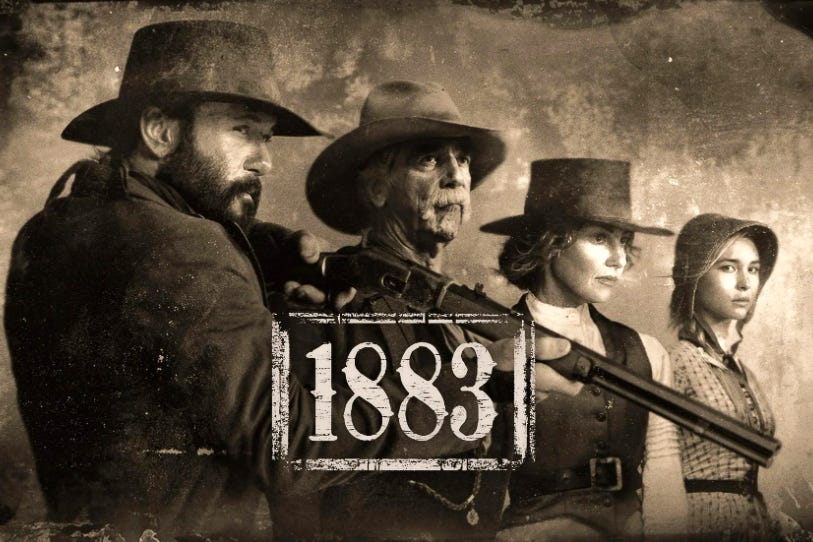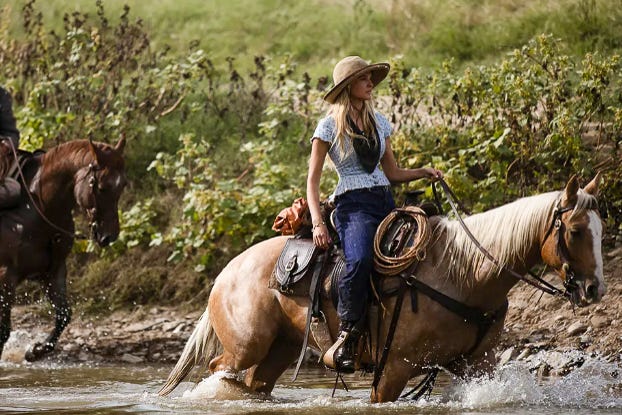1883: Real or Just Hollywood Shine? An Agricultural Spin on What’s True and What Ain’t
The Western series 1883 feels mighty real — but it ain’t no history book. This here fact check digs into which horses and cattle folks were haulin’ westward — and what they ate on the trek.

Between 1820 and 1920, 'round 10 million folks packed up from Germany, Austria, and Switzerland and headed across the pond to the good ol’ U.S. of A. For a spell there, German-speakin’ folks were the biggest bunch of newcomers in the land:
🇩🇪 Germany sent over some 5.5 million.
🇦🇹 Austria-Hungary — includin’ Bohemia and Moravia (now Czech Republic), Galicia (Poland/Ukraine), plus parts of Tyrol and Styria — added another 600,000 German-speakin’ souls (and ‘bout 3.5 million speakin’ all sorts o’ other tongues).
🇨🇭 And Switzerland? She gave 400,000 brave souls to the American dream.
Most were runnin’ from hard times — busted crops, empty bellies, no jobs — or from folks tryin’ to tell ’em how to pray or what to believe.
These folks didn’t bring much silver or gold, but they came loaded with grit: know-how in farmin’, ranchin’, and handywork, a sturdy faith — and the fire to start fresh from scratch.

1883 — Real Grit on the Small Screen
The Western series 1883 follows just such a group of settlers — mostly from German and Eastern European roots — and the Duttons, an Anglo-Irish bunch. In the year the show’s named after, they hit the trail in wagons from Texas, headin’ up toward Montana or maybe Oregon, takin’ near six months to get there.
1883 was a hit right outta the gate. Its 2021 debut pulled in over 10 million folks, makin’ it the biggest cable TV premiere in the U.S. that year. Every re-run grabbed another 2.5 million viewers.
It’s a rough ride o’ a show: raw, emotional, and mighty real-lookin’. You got disease and hunger, outlaws and bandits, storms and stubborn terrain — not to mention run-ins with Native folks along the way.
Historians tip their hats to how real it looks — from clothes to wagons to, yep, the lack of food on the table.
But what about the agriculture facts? Are the cows and horses on point? I saddled up to find out. Let’s hit the trail.

Fort Worth: Cattle, Chaos, and the Smell of Trouble
Back in 1883, Fort Worth, Texas was a rough 'n’ rowdy place — a crossroads for cowboys and dreamers, danger and dust. You could smell the mix of cattle, dung, and dried blood just steppin’ off the train.
It was one of the biggest cattle hubs in the country. That year alone, cowpokes drove 200,000 head north to Kansas and Colorado, and another 300,000 got loaded up on the trains.
It was also where hopeful settlers hitched up and rolled west — though many of ‘em didn’t make it far. Hunger, accidents, and bullets had their way with more than a few.
“In the saloons, whorehouses, and gamblin’ dens of Hell’s Half Acre, you won’t find no angels — just cowboys, drifters, and outlaws chasin’ luck or a fistful o’ cash.”
For 1883, Taylor Sheridan and crew hauled the city back in time, transformin’ modern-day Fort Worth into its gritty, dusty old self. Streets got sanded, sidewalks got stone’d, and buildings like the “White Elephant Saloon” got a fresh coat o’ history.
Filmin’ the Trek Took Just As Long As the Real Deal
The settlers’ route from Fort Worth to Montana’s Paradise Valley ran nearly 1,600 miles. Add a few hundred more if you were headin’ all the way to Oregon.
With wagons crawlin’ just 10 to 15 miles a day, the whole journey took five to six months — if weather, health, and luck held steady.
Shootin’ the show took just as long. From August 2021 in Texas to deep-winter Montana in January 2022, the crew filmed on location the whole way. They braved heat, cold, snow, and a whole lotta horse manure. Cast and crew called it the toughest job they ever had.

Wagons in 1883 Look Great — Maybe Too Great
Them covered wagons — “Prairie Schooners” — were the real deal back in the day. But they didn’t come from Texas. Most were built way up in the Midwest, in places like Saint Joseph, Missouri.
John Studebaker, a German-American fella, built over 75,000 of ‘em in 1883 alone. They sold for 80 to 150 bucks — a fortune when folks made just a dollar or two a day.
Solid wood frames, iron wheels, and canvas tops — though the white tops you see in the show ain’t quite right. Back then, they sealed that cloth with linseed oil and turpentine, turnin’ it yellow – and flammable as all get-out.

A Mixed Herd Ain’t Trail-Friendly
In the 1880s, Texas Longhorns ruled the range. Tough as nails, heatproof, and born to walk.
In 1883, the settlers buy themselves about 40 head — led along by Elsa Dutton and a couple o’ cowhands. But some of those cattle look mighty modern: Herefords or crosses with their stocky builds and white faces.
They may look purty, but they ain’t built for the trail. They tire out fast, need more water and breaks, and get heatstroke quicker than a lizard on a hot rock.
Also, cattle weren’t cheap. Ten to twenty-five bucks a head, even more for dairy or breedin’ stock. A herd like that would cost hundreds, maybe a thousand dollars — way more than poor settler folk had to spare.

Them Horses Sure Are Pretty — Maybe Too Pretty
You’ll spot a lotta Palomino horses in the show — golden coats and flaxen manes, shinin’ like a preacher’s promise. Elsa Dutton rides one fine-lookin’ mare.
But back then, settlers didn’t ride show ponies. They needed tough, scrappy animals — grade horses, draft crosses, mustangs. Horses that didn’t mind bad roads and worse grub.
The one Elsa rides might turn heads in a parade, but she wouldn’t have lasted halfway to Oregon.

Meals on the Trail: Mush, Mush, Mush and Maybe Bacon
Food was basic and bland. No fancy fixin’s, just what’d last and fill your belly.
"Mornin’s we get warm mush, noon it’s cold mush, and come supper, it’s the scraps — if luck’s on our side, maybe with a sliver o’ bacon.”
Oats or corn grits, cooked in water, maybe a touch of lard or salt. Pancakes (“slapjacks”) made from flour and water fried in a skillet. Beef was too valuable to eat unless times were dire. Folks hunted for rabbits, deer, or birds — if they got lucky.
In the show, folks eat their mush from tin bowls — that’s spot-on. Elsa shootin’ a bison? Dramatic, sure — but unlikely. Most bison near the wagon trails were long gone by then.
They did eat rattlesnake when needed, and foraged berries, roots, and plants — though the series don’t show much o’ that.
“1883” Blends Grit with Glory
It ain’t a documentary, and it don’t pretend to be. 1883 is a TV tale — part true, part movie magic. But it gets a whole lot right.
Sure, some things sparkle too much — white wagons, shiny horses, a lead gal who stays picture-perfect after months on the trail. But that don’t mean it ain’t real at heart.
The trek West wasn’t no storybook. It was a fight for food, for hope, for life. 1883 shows that grit better than most ever dared.


